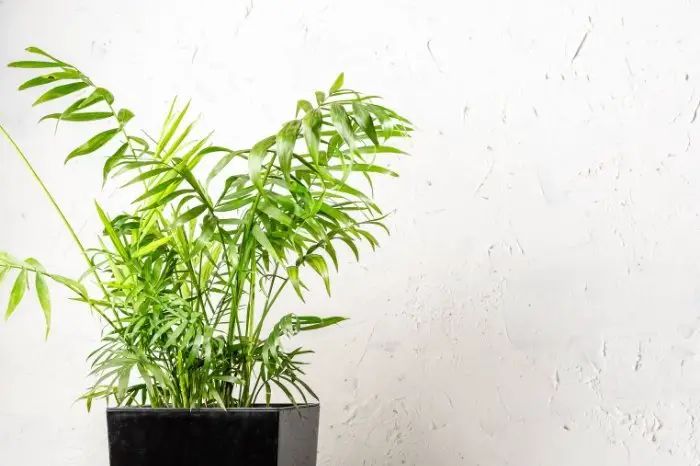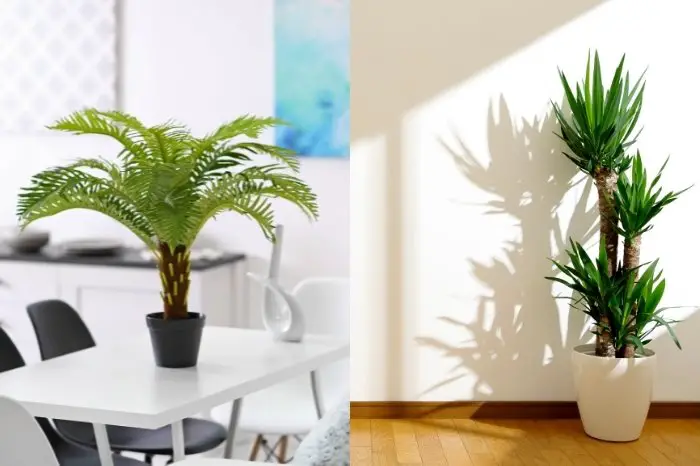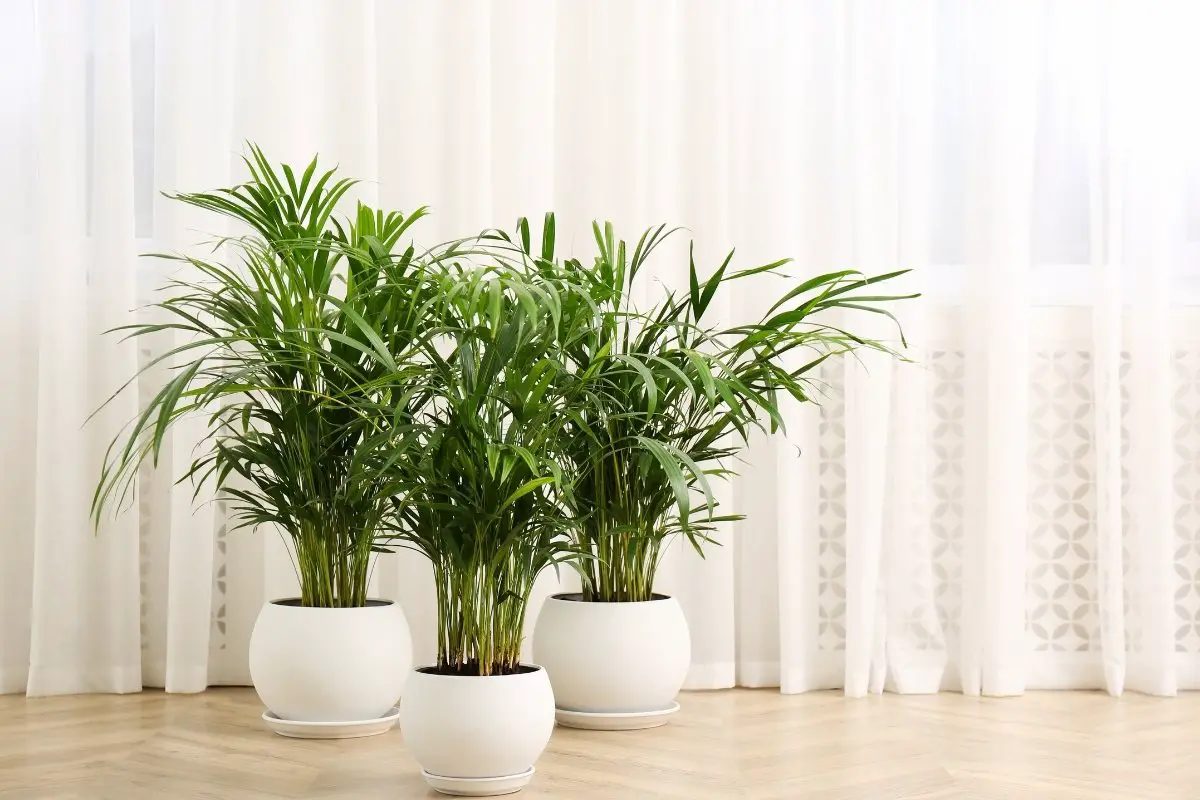Last Updated on January 23, 2022 by Fabiola L.
Indoor palm plant identification is a fun topic that will benefit most gardeners who love to grow palm plants in their houses.
Indoor palm plants are excellent for bringing the atmosphere of the tropics into your home. Most palm house plants have pointed leaflets with arching fronds on their stems.
Growing Palms indoors helps improve the feel of any room in your office or home. Growing these plants is relatively easy though it requires some specific care requirements.
The most popular indoor palm house plants are the majestic palms, areca Palms, parlour palms, cat palms, and kentia palms. These are well-known palm plants that don’t take up too much room and help brighten up your living space with their elegant foliage.
So if you meet a gardener who asks if you can have indoor palm trees, let them know they can grow as many as they want.
Indoor Palm Plant Identification
We will look at the types of indoor palm plants you can grow. They include:
Parlour Palm
It is one of the world’s most famous house plants that purify the air. The parlour palm thrives in average indoor light and high levels of humidity. It is a slow-growing tropical palm with crescent-shaped leaves and grows up to around 6 feet tall, but it may take years of regular care to reach its full height.

Chinese Fan Palm
This is one of the most incredible and unique palm plants for your home. Its fronds are dark green and shaped like a star looking elegant in a sunny room. The Chinese fan palm, also known as fountain palm, is a slow grower like most palms. It grows to 10 feet and is widespread, giving plenty of space in a bright, airy room.
Areca Palm
Areca palm is also known as the butterfly palm due to its feathery arched fronds that look like a butterfly. It has long stems and green foliage that looks similar to bamboo. This palm plant grows in clumps, and it has thin arching that looks like palm grass.
Read more about:
Cat Palm
This type is also known as the cascade palm. It is a small palm tree suitable for bright light and sunny locations if the sun does not shine directly on the leaves. Its green foliage is long and slender. This bushy foliage makes it an excellent plant to brighten the upper corner and grow up to 3.3 ft tall.
Ponytail Palm
Also known as elephant’s foot palm this variety has crowning leaves that sit on top of a thick trunk or stem. Even when grown in small pots, its base is somewhat larger than the stem base. This pill looks like an elephant’s foot and thrives indoors and outdoors in a temperate climate. It is suitable as a tabletop plant or any room with no direct sunlight and light shade.
American Plant Exchange Ponytail Palm Single Trunk Live Plant, 6″ Pot, Indoor/Outdoor
Majestic Palm
This indoor palm plant is excellent to cheer a dim corner of your home. It has long arching fronds that are quite an attraction when grown indoors. This type thrives in moist soil consistent warmth and requires plenty of air moisture. It can grow up to 98 ft tall taking many years to reach that height.
Find more information about Cat Palm vs Majesty Palm – 5 Interesting Things
Bamboo Palm
This pal is a decorative plant with bushy foliage similar to growing bamboo. It has clumps of slender cane-like stems with leaves growing together to create dense greenery. Bamboo poles grow up to 3 feet tall and thrive in the shade. This species is related to the parlour palm and shares a common name with the areca palm.
Check Out How Fast Do Windmill Palm Trees Grow?
Kentia Palm
This is an elegant palm plant that is difficult to beat. This ornamental palm features gorgeous green leaves growing upward and arching slightly. It is one of the most shade tolerant palms on this list. It is easy to care for and drought tolerant and doesn’t even mind the cold. This poem does not grow too large and requires moist soil and humid air.
Lady’s Palm
This variety has outstanding features of broadleaf shining dark green fronds and lush growing nature. It looks more like bamboo as it grows in pots full stop and like other indoor palm plants the ends of the leaves have sawtooth ends that are not tapered.
Fishtail Palm
Fishtail palms are not as common as the other pounds, but that does not mean they are not gorgeous house plants. They have uniquely shaped leaves, interesting texture and upward growth habit that makes this plant a stunner. This plant thrives in bright spots where it doesn’t get direct sunlight.
Click here for A Guide On Where To Plant Bee Balm
European Fan Palm
This palm is similar to the Chinese fan palm, but it has spiky fronds growing in a star shape. This plant is easy to grow as it doesn’t mind being in the shade. They even thrive in regular room humidity something that most palms do not. A European fan palm is a small house plant that is quite manageable. They are usually sold when they are about 1 ft tall and, after a few years, will grow to about 3 feet high. They are slow-growing plants reaching their full height after about 10 years or so.
What Indoor Plant Looks Like A Palm Tree, But It’s Not A True Palm
Several plants look like palm trees, and most people confuse them for true palms. They include
- Sago Palm. This beautiful house plant has a touch of class to a sunny room. Though it is called a palm and looks like one, it belongs to the family of Cycadaceae. The short plump fuzzy drunk looks like a pineapple growing out of the ground they have thick stems long stiff fronds that arch out and have leaflets growing upward. This plant has a lifespan of about 15 years as an indoor plant. To keep it driving, provide enough water, keep humidity high and place it in bright light.
- Yucca. Yuccas are not true palms, but they require the same growing conditions as the palms. They thrive in partly shaded areas and can tolerate periods of dryness. A yucca plant is an excellent choice if you do not get a lot of sunlight in your home but still need some greenery.

How Do You Look After Indoor Palm Plants?
Indoor palm plants can be more demanding than a houseplant even though they tolerate periods of dryness. Providing them with enough light keeping humidity high, and watering correctly are some of the primary care requirements these plants need. Here Are The Most Important Requirements:
- Light. Almost all pal varieties prefer bright indirect light. Too much direct sunlight tends to burn their leaves to the point of drying. Indoor palms do not do well in dim light so choose a location that gets plenty of morning or evening sun but remember to protect it from the suns direct rays.
- Water. Indoor power plants require high humidity to thrive because they are tropical plants. To resolve humidity problems in palms, mist the leaves daily or use a humidifier to provide adequate moisture.
Conclusion
Indoor palm plant identification is not as complicated as most gardeners think. There are not many palm plant look-alikes that grow in the place of a true palm. This makes it easy to identify the actual palm plants.
Caroline is a gardener who loves to get down to the nitty–gritty of gardening. She proudly proclaims herself as a ‘dirt worshipper‘ and can often be found deep in the garden, covered in soil and singing to her plants. As a self–proclaimed ‘plant whisperer‘, Caroline believes that plants need love and attention just like any other living thing, and she loves to give them both. When she‘s not tending to her garden, you can often find her researching the latest gardening trends, or teaching others how to make their gardens thrive



